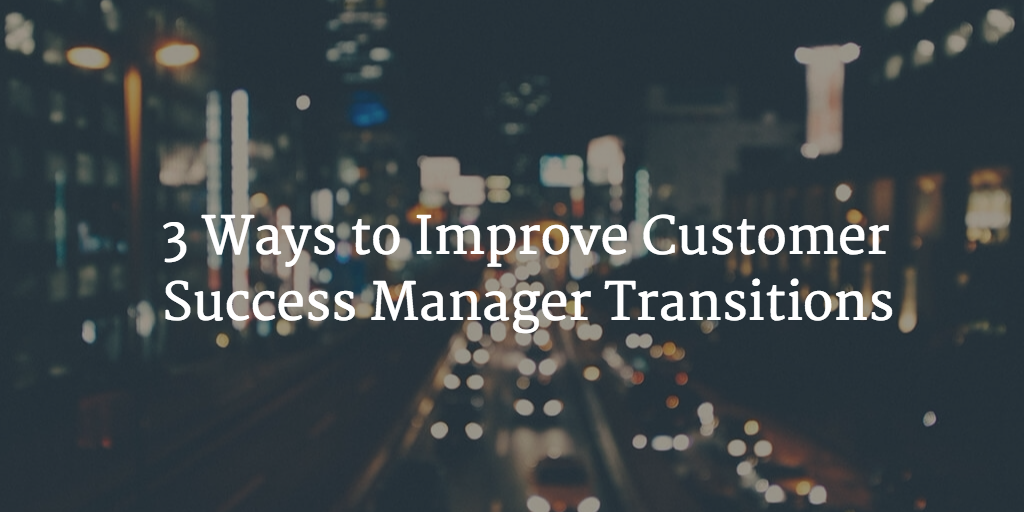If you’ve ever had – or ever will have – turnover in your Customer Success Management organization, this article will help you improve the transition from one Customer Success Manager to another, ensuring your customers have a seamless, painless experience.
In the Customer Success industry, we frequently talk about nailing the handoffs from group to group (Sales to Onboarding, Onboarding to Customer Success Management, etc.), to ensure the customer has a seamless experience as they move through their lifecycle with you.
But what about those handoffs from one Customer Success Manager (CSM) to another when something happens (promotion, attrition, territory/customer-segment change, etc.)?
While we talk about onboarding new CSMs a lot – which is something every single organization will have to deal with – the transitions between CSMs is also something that every organization will have to deal with, but this topic is rarely talked about.
Until now…
Here are 3 Ways to Improve Customer Success Manager Transitions
1. Properly Manage Expectations
While you don’t want to prematurely introduce the possibility of disruptions, especially in the fragile early-days of a relationship, you must properly manage expectations.
If you know a change is in the works, know that you have a higher-than-usual turnover rate, or otherwise know that the CSM the customer is going to work with at first won’t be their CSM for the duration, manage that expectations up front.
And if the transition is due to a potentially negative reason – i.e. the CSM was let go due to unprofessional conduct – there may some venting that the customer will want to do, as they may have been on the receiving end of the unprofessional conduct. If so, make sure they’re given a forum to vent and be heard, but let them know that it’s taken care of and you’re moving forward.
2. Document Everything with the New CSM in Mind
Has anything like this ever happened to you? I called the vet to see if my dog was ready to be picked-up. The person said they’d go see and put me on hold. Another person took me off hold and asked how they could help; I asked if my dog was ready to be picked-up… they said they’d go find out and put me on hold.
A third person took me off hold and asked if they could help. I said I just wanted to know if my dog was ready to be picked-up and that two other people were already on the case. They said they’d find out and put me back on hold. One of the three then came back and said that yes, my dog was ready to be picked-up.
(Of course, they could have just called, texted, or emailed me when he was ready…. but that’s a story for another day.)
Ultimately, it wasn’t that bad; it only took 2 or 3 minutes and is something I rarely have to deal with.
But if you’re a vendor your customers have to “deal with” on a frequent basis as a requirement of getting their job done, this type of thing – asking the same question (or getting asked the same question) by multiple people – can be a deal-breaker over time.
Aside from this being one of the most annoying things to customers, it’s time-consuming and gives the (possibly true) impression that you’re not really listening, don’t respect their time, and ultimately just don’t care.
This can – and often is – exacerbated by multiple people performing the same role with the same customer, but without any visibility into what the other person who was helping the customer was doing.
So my recommendation is to document every interaction with the customer in as much detail as is realistic and attach that to their customer record so the next CSM – or anyone else – can pick up from where the other CSM left-off without having to repeat questions. This is so simple to implement… but so easy to overlook.
3. Centralize and Operationalize Processes
Documenting the CSM’s interactions with a customer will ensure consistency from CSM to CSM, eliminating a lot of the redundant Q&A that customers can find annoying.
But if you want to take even more inconsistency out of the CSM to CSM handoff process, further ensuring your customers will experience less pain, annoyance, and disruption, then you need to ensure your CSMs are all following the same playbook.
Documenting your processes, workflows, playbooks, etc. in one central location will ensure all CSMs are working with all similar customers (a certain segment, cohort, etc.) the same way. This type of setup is critical not only for CSM to CSM handoffs, but is absolutely a prerequisite for scaling a Customer Success Management organization.
And no, I don’t have a number of CSMs where you should start implementing this. If you have a process today, and you have one CSM, document that and put it somewhere central so that when you bring on CSM #2 they can instantly be on the same page as CSM #1. And if changes are needed along the way (and they will be), once they’re changed centrally, #1 and #2 will be on the same page. When #3 comes along, they’ll be on the same page, too.
BTW, this is where a product like Gainsight really shines. I like to say we put the “Management” in Customer Success Management, as our product takes the idea of centralized CSM operations to the next level, empowering your team with the playbooks and Calls to Action.
If you haven’t seen that in person, you definitely need to get a demo of Gainsight. It’s game changing.
In fact, you should check out this article by Dan Steinman, our CCO at Gainsight, about how you can get value from Gainsight without any data integrations… it’s all about playbooks and CTAs.

